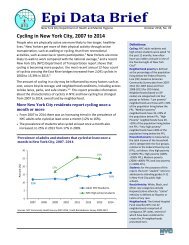2013-dot-sustainable-streets-lowres
2013-dot-sustainable-streets-lowres
2013-dot-sustainable-streets-lowres
You also want an ePaper? Increase the reach of your titles
YUMPU automatically turns print PDFs into web optimized ePapers that Google loves.
INFRASTRUCTURE25NYC transportationprojects saved from cutsby stimulus fundingFEDERAL STIMULUS FUNDINGNew York City received $1.1 billion for transportation projects fromthe American Recovery and Reinvestment Act in 2009, including$261 million for NYC DOT. The allocation was the largest to anycity in the country and allowed the city to create or preserveapproximately 32,000 jobs. New York was able to take maximumadvantage of the opportunity because of its sophisticated projectdevelopment process and expertise in federal transportation law.Existing funding for stimulus projects allowed 25 other projects toproceed, projects that would have languished due to the economicdownturn. Examples include the reconstruction of Eastern Parkwayin Brooklyn and East Houston Street in Manhattan and constructionof the Hunts Point Greenway in the Bronx. Six NYC DOT projectsreceived direct stimulus funding.Rehabilitation of Saint George Ferry Terminal RampsAt $175 million, the project at the St George Ferry Terminal wasthe largest stimulus project in New York State. The Terminal isStaten Island’s transit hub linking 70,000 daily commuters with theStaten Island Railroad, 20 New York City Transit bus lines, 3 parkingfacilities and the Bay Street and Richmond Terrace bikeway.The project consists of the rehabilitation of 8 ramps and wascompleted using the Design Build approach, a modern method ofproject delivery in which the city enters into a single contract withone entity for both design and construction services. This permitsconstruction to begin while design continues in close coordination,enabling the construction to be completed in less than 3 years understrict cost control. Replacement of the ramps will reduce long termexpenditures for the city.Rehabilitation of the Brooklyn BridgeThis project includes rehabilitating ramps and repainting the bridgeto improve traffic conditions for 100,000 vehicles and 4,000pedestrians and 2,600 bicyclists who cross the Brooklyn Bridgeevery day.Total Project Cost: $500 millionDirect Stimulus Funding: $30 millionUpgrades to the Ward’s Island Pedestrian BridgeThe project improved pedestrian access to Ward’s Island from EastHarlem through a complete mechanical and electrical rehabilitation,including replacing the complete tower drive machinery, providinga new reinforced concrete deck, and a new drainage system. Theproject was done in tandem with a $100 million upgrade to Ward’sIsland recreational facilities, including construction of Icahn Stadiumand dozens of new ball fields. The project improved pedestrian safetyand durability and extended the useful life of the existing bridge.Total Project Cost: $14.3 millionDirect Stimulus Funding: $14.3 millionRehabilitation of 12 Roadway BridgesRehabilitation of deteriorated components of 12 bridges throughoutthe City extended their useful life by 10 years. Rehabilitationwork addressed concrete abutments, piers and columns, bearingreplacements, resurfacing steel repairs and waterproofing.Total Project Cost: $175 millionDirect Stimulus Funding: $175 millionTotal Project Cost: $9.7 millionDirect Stimulus Funding: $9.7 million180Chapter 13: A City of Bridges



